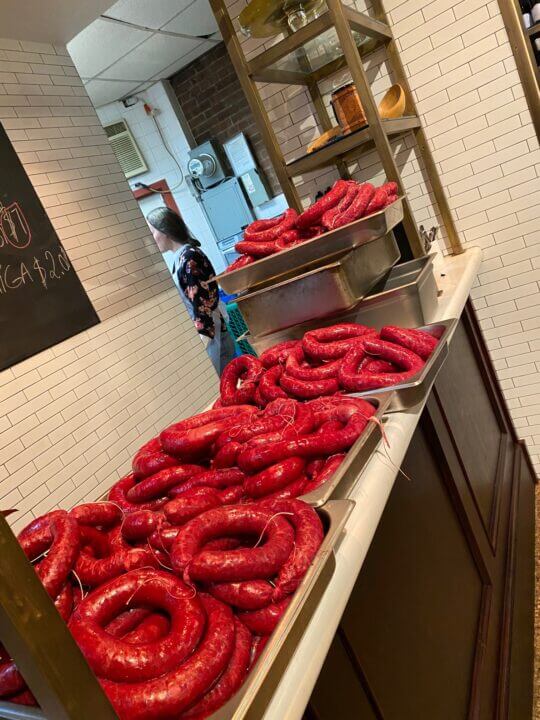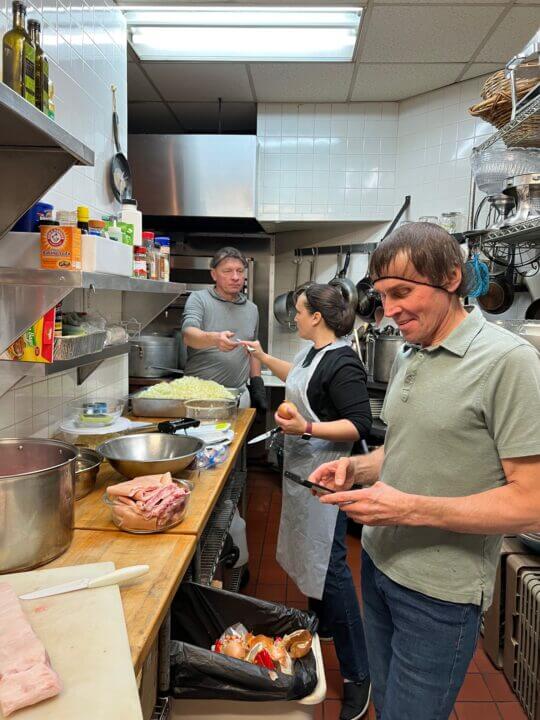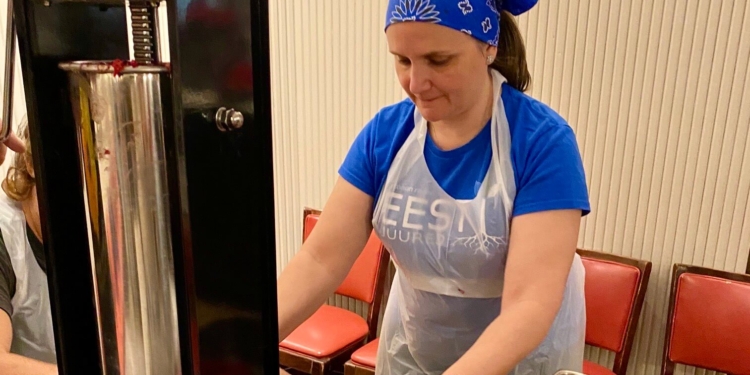“Tööle!” Liisi claps. In the early afternoon of Saturday, November 19, the New York Estonian House held its annual November Blood Sausage Workshop. Organized by Liisi Vanaselja Fletcher and Argo Paomere, the workshop attracted about twenty participants, with annual workshop regulars and a few fresh faces coming in from across the New York and New Jersey region.
While many have family traditions of making blood sausages, coming together at the New York Estonian House offers a different slice of community. Around the room, the age ranges from teenagers to grandmothers as participants suit up in black hair nets and white plastic aprons and gloves, preparing to slide intestines onto funnels and machines. “I have been running this workshop for about five years now,” Liisi says. “But my brother, Siim, ran the workshop for fifteen or twenty years before me.” Liisi asks her mother, sitting next to her, if that sounds right, and she smiles at the man across the table, who she says has been making sausage with them for at least ten years.



All the chairs in the Estonian House’s restaurant have been moved aside to leave two square tables in the middle of the floor. The first table has three stations with orange funnels and wooden sticks—we pull the end of an intestine around the mouth of the funnel, and then spoon the sausage filling, made with fresh meat, pig’s blood, and, according to Liisi, lots of garlic and onion, into the funnel’s top. To fill the sausages, we push the filling through the funnel’s mouth with the wooden stick, and a partner squeezes the filling to the bottom of the sausage until the intestine is full. Two tall, metal machines stood on the second table—these do the work of the wooden stick, with a crank pushing the filling through a tube and into the intestine.
As participants pull the sausages full and tie them off, laughter and happy chatter in Estonian echo around the room. And not just from the regulars in attendance. “It’s great that young people are coming to this, too,” says Heili Springsteen, a member of the Cultural Committee Board. “It’s cooking; it’s interesting; it’s something to do.” People come and go throughout the event, and last year, Spring-steen says, the last of the workshop participants stuck around until one or two in the morning.
For Ketri Nõlvak, this workshop is the first opportunity she has had to speak Estonian in the two months since arriving from Tallinn for her job as an au pair in the city. She, Heili, and I chat about Nublu’s performance at the house’s Cultural Days in the spring, and Liisi asks how we know each other. “We all just met!” Heili responds. Later, I look around the room and ask her who she knows here. She points people out, explaining how she knows them and when she saw them last. “This is the way the community is,” she smiles. “Everyone is so close-knit.”
And, in an exciting change, this is the first year that the workshop was able to make the traditional sausage with fresh blood. “It’s always difficult to find pig’s blood in the United States,” Liisi says. “But a friend told us about a place in New Jersey.” The butcher sells whole pigs but needs to drain the blood beforehand, and purchasing this blood allows the Estonian House to make fresher sausages than they would be able to with the typical cow’s blood used in the past. Many participants remarked on the color of the sausage—it was pinker than the color last year. “Cow’s blood is redder, and it is normally frozen. This pigs’ blood has never been frozen,” Liisi explains. And she had a surprise for the participants, thanks to the new shop: pieces of pig skin that had been roasting in the oven for the duration of the workshop—seakrõmpsud!
Jõudu to all making blood sausage this holiday season! In December, you can look forward to the New York Estonian House’s Christmas Market on December 3, a holiday jazz concert on December 9, the New York Estonian Educa-tional Society Christmas Party on December 17, and the New Year’s Eve Party on December 31.
















